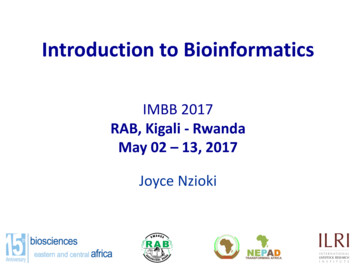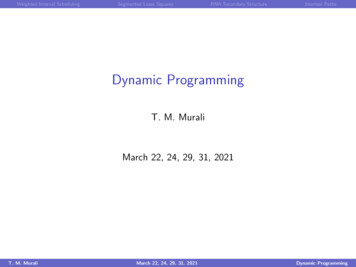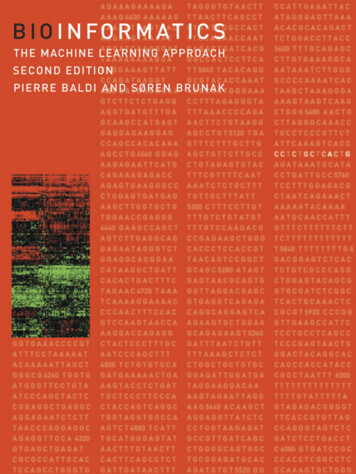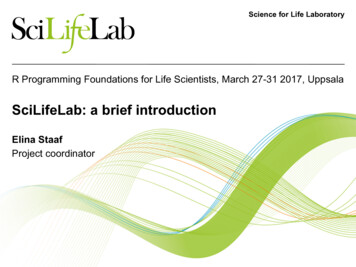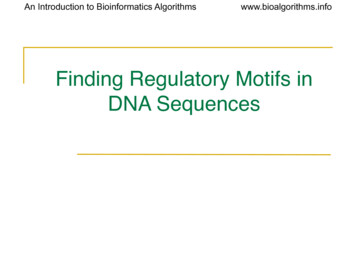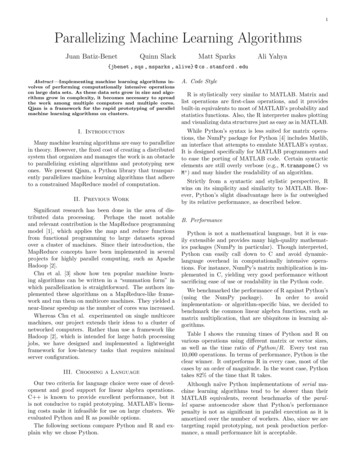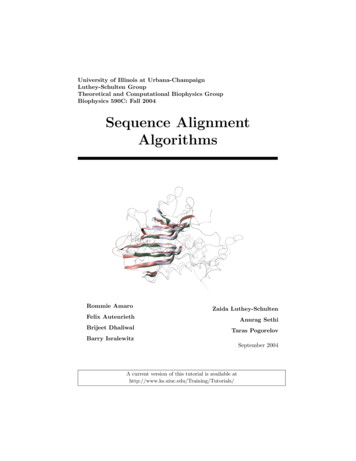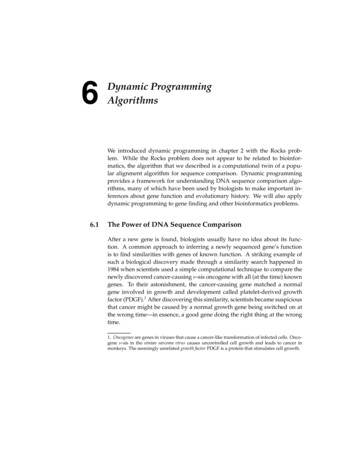
Transcription
6Dynamic ProgrammingAlgorithmsWe introduced dynamic programming in chapter 2 with the Rocks problem. While the Rocks problem does not appear to be related to bioinformatics, the algorithm that we described is a computational twin of a popular alignment algorithm for sequence comparison. Dynamic programmingprovides a framework for understanding DNA sequence comparison algorithms, many of which have been used by biologists to make important inferences about gene function and evolutionary history. We will also applydynamic programming to gene finding and other bioinformatics problems.6.1The Power of DNA Sequence ComparisonAfter a new gene is found, biologists usually have no idea about its function. A common approach to inferring a newly sequenced gene’s functionis to find similarities with genes of known function. A striking example ofsuch a biological discovery made through a similarity search happened in1984 when scientists used a simple computational technique to compare thenewly discovered cancer-causing ν-sis oncogene with all (at the time) knowngenes. To their astonishment, the cancer-causing gene matched a normalgene involved in growth and development called platelet-derived growthfactor (PDGF).1 After discovering this similarity, scientists became suspiciousthat cancer might be caused by a normal growth gene being switched on atthe wrong time—in essence, a good gene doing the right thing at the wrongtime.1. Oncogenes are genes in viruses that cause a cancer-like transformation of infected cells. Oncogene ν-sis in the simian sarcoma virus causes uncontrolled cell growth and leads to cancer inmonkeys. The seemingly unrelated growth factor PDGF is a protein that stimulates cell growth.
1486Dynamic Programming AlgorithmsAnother example of a successful similarity search was the discovery of thecystic fibrosis gene. Cystic fibrosis is a fatal disease associated with abnormalsecretions, and is diagnosed in children at a rate of 1 in 3900. A defective genecauses the body to produce abnormally thick mucus that clogs the lungs andleads to lifethreatening lung infections. More than 10 million Americans areunknowing and symptomless carriers of the defective cystic fibrosis gene;each time two carriers have a child, there is a 25% chance that the child willhave cystic fibrosis.In 1989 the search for the cystic fibrosis gene was narrowed to a regionof 1 million nucleotides on the chromosome 7, but the exact location of thegene remained unknown. When the area around the cystic fibrosis gene wassequenced, biologists compared the region against a database of all knowngenes, and discovered similarities between some segment within this regionand a gene that had already been discovered, and was known to code foradenosine triphosphate (ATP) binding proteins.2 These proteins span the cellmembrane multiple times as part of the ion transport channel; this seemeda plausible function for a cystic fibrosis gene, given the fact that the diseaseinvolves sweat secretions with abnormally high sodium content. As a result,the similarity analysis shed light on a damaged mechanism in faulty cysticfibrosis genes.Establishing a link between cancer-causing genes and normal growth genesand elucidating the nature of cystic fibrosis were only the first success storiesin sequence comparison. Many applications of sequence comparison algorithms quickly followed, and today bioinformatics approaches are amongthe dominant techniques for the discovery of gene function.This chapter describes algorithms that allow biologists to reveal the similarity between different DNA sequences. However, we will first show howdynamic programming can yield a faster algorithm to solve the Change problem.6.2The Change Problem RevisitedWe introduced the Change problem in chapter 2 as the problem of changingan amount of money M into the smallest number of coins from denominations c (c1 , c2 , . . . , cd ). We showed that the naive greedy solution used bycashiers everywhere is not actually a correct solution to this problem, andended with a correct—though slow—brute force algorithm. We will con2. ATP binding proteins provide energy for many reactions in the cell.
6.2 The Change Problem Revisited149sider a slightly modified version of the Change problem, in which we donot concern ourselves with the actual combination of coins that make upthe optimal change solution. Instead, we only calculate the smallest numberof coins needed (it is easy to modify this algorithm to also return the coincombination that achieves that number).Suppose you need to make change for 77 cents and the only coin denominations available are 1, 3, and 7 cents. The best combination for 77 cents willbe one of the following: the best combination for 77 1 76 cents, plus a 1-cent coin; the best combination for 77 3 74 cents, plus a 3-cent coin; the best combination for 77 7 70 cents, plus a 7-cent coin.For 77 cents, the best combination would be the smallest of the above threechoices. The same logic applies to 76 cents (best of 75, 73, or 69 cents), andso on (fig. 6.1). If bestN umCoinsM is the smallest number of coins needed tochange M cents, then the following recurrence relation holds:bestN umCoinsM bestN umCoinsM 1 1 minbestN umCoinsM 3 1 bestN umCoinsM 7 1In the more general case of d denominations c (c1 , . . . , cd ):bestN umCoinsM bestN umCoinsM c1 1 bestN umCoinsM c2 1 min. . bestN umCoinsM cd 1This recurrence motivates the following algorithm:
150677Dynamic Programming 757473727170696867Figure 6.1 The relationships between optimal solutions in the Change problem. Thesmallest number of coins for 77 cents depends on the smallest number of coins for 76,74, and 70 cents; the smallest number of coins for 76 cents depends on the smallestnumber of coins for 75, 73, and 69 cents, and so on.R ECURSIVE C HANGE(M, c, d)1 if M 02return 03 bestN umCoins 4 for i 1 to d5if M ci6numCoins R ECURSIVE C HANGE (M ci , c, d)7if numCoins 1 bestN umCoins8bestN umCoins numCoins 19 return bestN umCoinsThe sequence of calls that R ECURSIVE C HANGE makes has a feature in common with the sequence of calls made by R ECURSIVE F IBONACCI, namely, thatR ECURSIVE C HANGE recalculates the optimal coin combination for a givenamount of money repeatedly. For example, the optimal coin combinationfor 70 cents is recomputed repeatedly nine times over and over as (77 7),(77 3 3 1), (77 3 1 3), (77 1 3 3), (77 3 1 1 1 1),(77 1 3 1 1 1), (77 1 1 3 1 1), (77 1 1 1 3 1),(77 1 1 1 1 3), and (77 1 1 1 1 1 1 1). The optimal
6.2 The Change Problem Revisited151coin combination for 20 cents will be recomputed billions of times renderingR ECURSIVE C HANGE impractical.To improve R ECURSIVE C HANGE, we can use the same strategy as we didfor the Fibonacci problem—all we really need to do is use the fact that thesolution for M relies on solutions for M c1 , M c2 , and so on, and thenreverse the order in which we solve the problem. This allows us to leverage previously computed solutions to form solutions to larger problems andavoid all this recomputation.Instead of trying to find the minimum number of coins to change M cents,we attempt the superficially harder task of doing this for each amount ofmoney, m, from 0 to M . This appears to require more work, but in fact, itsimplifies matters. The following algorithm with running time O(M d) calculates bestN umCoinsm for increasing values of m. This works because thebest number of coins for some value m depends only on values less than m.DPC HANGE(M, c, d)1 bestN umCoins0 02 for m 1 to M3bestN umCoinsm 4for i 1 to d5if m ci6if bestN umCoinsm ci 1 bestN umCoinsm7bestN umCoinsm bestN umCoinsm ci 18 return bestN umCoinsMThe key difference between R ECURSIVE C HANGE and DPC HANGE is thatthe first makes d recursive calls to compute the best change for M (and eachof these calls requires a lot of work!), while the second analyzes the d alreadyprecomputed values to almost instantly compute the new one. As surprisingas it may sound, simply reversing the order of computations in figure 6.1makes a dramatic difference in efficiency (fig. 6.2).We stress again the difference between the complexity of a problem andthe complexity of an algorithm. In particular, we initially showed an O(M d )algorithm to solve the Change problem, and there did not appear to be anyeasy way to remedy this situation. Yet the DPC HANGE algorithm providesa simple O(M d) solution. Conversely, a minor modification of the Changeproblem renders the problem very difficult. Suppose you had a limited number of each denomination and needed to change M cents using no more thanthe provided supply of each coin. Since you have fewer possible choices in
1526Dynamic Programming Algorithms000 10 10 1 20 1 20 1 2 30 1 2 10 1 2 3 40 1 2 1 20 1 2 3 4 50 1 2 1 2 30 1 2 3 4 5 60 1 2 1 2 3 20 1 2 3 4 5 6 70 1 2 1 2 3 2 10 1 2 3 4 5 6 7 80 1 2 1 2 3 2 1 20 1 2 3 4 5 6 7 8 90 1 2 1 2 3 2 1 2 3Figure 6.2 The solution for 9 cents (bestN umCoins9 ) depends on 8 cents, 6cents and 2 cent, but the smallest number of coins can be obtained by computingbestN umCoinsm for 0 m 9.this new problem, it would seem to require even less time than the originalChange problem, and that a minor modification to DPC HANGE would work.However, this is not the case and this problem turns out to be very difficult.
6.3 The Manhattan Tourist Problem6.3153The Manhattan Tourist ProblemWe will further illustrate dynamic programming with a surprisingly usefultoy problem, called the Manhattan Tourist problem, and then build on thisintuition to describe DNA sequence alignment.Imagine a sightseeing tour in the borough of Manhattan in New York City,where a group of tourists are determined to walk from the corner of 59thStreet and 8th Avenue to the Chrysler Building at 42nd Street and Lexington Avenue. There are many attractions along the way, but assume for themoment that the tourists want to see as many attractions as possible. Thetourists are allowed to move either to the south or to the east, but even so,they can choose from many different paths (exactly how many is left as aproblem at the end of the chapter). The upper path in figure 6.3 will takethe tourists to the Museum of Modern Art, but they will have to miss TimesSquare; the bottom path will allow the tourists to see Times Square, but theywill have to miss the Museum of Modern Art.The map above can also be represented as a gridlike structure (figure 6.4)with the numbers next to each line (called weights) showing the number ofattractions on every block. The tourists must decide among the many possible paths between the northwesternmost point (called the source vertex) andthe southeasternmost point (called the sink vertex). The weight of a path fromthe source to the sink is simply the sum of weights of its edges, or the overallnumber of attractions. We will refer to this kind of construct as a graph, theintersections of streets we will call vertices, and the streets themselves willbe edges and have a weight associated with them. We assume that horizontaledges in the graph are oriented to the east like while vertical edges are oriented to the south like . A path is a continuous sequence of edges, and thelength of a path is the sum of the edge weights in the path.3 A more detaileddiscussion of graphs can be found in chapter 8.Although the upper path in figure 6.3 is better than the bottom one, in thesense that the tourists will see more attractions, it is not immediately clear ifthere is an even better path in the grid. The Manhattan Tourist problem is tofind the path with the maximum number of attractions,4 that is, a longest path3. We emphasize that the length of paths in the graph represent the overall number of attractionson this path and has nothing to do with the real length of the path (in miles), that is, the distancethe tourists travel.4. There are many interesting museums and architectural landmarks in Manhattan. However,it is impossible to please everyone, so one can change the relative importance of the types ofattractions by modulating the weights on the edges in the graph. This flexibility in assigningweights will become important when we discuss scoring matrices for sequence comparison.
1546Dynamic Programming Algorithms(a path of maximum overall weight) in the grid.Manhattan Tourist Problem:Find a longest path in a weighted grid.Input: A weighted grid G with two distinguished vertices:a source and a sink.Output: A longest path in G from source to sink.Note that, since the tourists only move south and east, any grid positionswest or north of the source are unusable. Similarly, any grid positions southor east of the sink are unusable, so we can simply say that the source vertexis at (0, 0) and that the sink vertex at (n, m) defines the southeasternmostcorner of the grid. In figure 6.4 n m 4, but n does not always haveto equal m. We will use the grid shown in figure 6.4, rather than the onecorresponding to the map of Manhattan in figure 6.3 so that you can see anontrivial example of this problem.The brute force approach to the Manhattan Tourist problem is to searchamong all paths in the grid for the longest path, but this is not an optionfor even a moderately large grid. Inspired by the previous chapter you maybe tempted to use a greedy strategy. For example, a sensible greedy strategy would be to choose between two possible directions (south or east) bycomparing how many attractions tourists would see if they moved one blocksouth instead of moving one block east. This greedy strategy may provide rewarding sightseeing experience in the beginning but, a few blocks later, maybring you to an area of Manhattan you really do not want to be in. In fact,no known greedy strategy for the Manhattan Tourist problem provides anoptimal solution to the problem. Had we followed the (obvious) greedy algorithm, we would have chosen the following path, corresponding to twentythree attractions.55. We will show that the optimal number is, in fact, thirty-four.
6.3 The Manhattan Tourist Problem155Figure 6.3 A city somewhat like Manhattan, laid out on a grid with one-way streets.You may travel only to the east or to the south, and you are currently at the northwesternmost point (source) and need to travel to the southeasternmost point (sink).Your goal is to visit as many attractions as possible.
1566321403210611453523433257444600224Dynamic Programming Algorithms2835322Figure 6.4 Manhattan represented as a graph with weighted 1220523223Instead of solving the Manhattan Tourist problem directly, that is, findingthe longest path from source (0, 0) to sink (n, m), we solve a more generalproblem: find the longest path from source to an arbitrary vertex (i, j) with0 i n, 0 j m. We will denote the length of such a best path as si,j ,noticing that sn,m is the weight of the path that represents the solution to the
1576.3 The Manhattan Tourist ProblemManhattan Tourist problem. If we only care about the longest path between(0, 0) and (n, m)—the Manhattan Tourist problem—then we have to answerone question, namely, what is the best way to get from source to sink. If wesolve the general problem, then we have to answer n m questions: what isthe best way to get from source to anywhere. At first glance it looks like wehave just created n m different problems (computing (i, j) with 0 i nand 0 j m) instead of a single one (computing sn,m ), but the fact thatsolving the more general problem is as easy as solving the Manhattan Touristproblem is the basis of dynamic programming. Note that DPC HANGE alsogeneralized the problems that it solves by finding the optimal number ofcoins for all values less than or equal to M .Finding s0,j (for 0 j m) is not hard, since in this case the tourists donot have any flexibility in their choice of path. By moving strictly to the east,the weight of the path s0,j is the sum of weights of the first j city blocks.Similarly, si,0 is also easy to compute for 0 i n, since the tourists moveonly to the 142332Now that we have figured out how to compute s0,1 and s1,0 , we can compute s1,1 . The tourists can arrive at (1, 1) in only two ways: either by traveling south from (0, 1) or east from (1, 0). The weight of each of these pathsis s0,1 weight of the edge (block) between (0,1) and (1,1);
1586Dynamic Programming Algorithms s1,0 weight of the edge (block) between (1,0) and (1,1).Since the goal is to find the longest path to, in this case, (1, 1), we choose thelarger of the above two quantities: 3 0 and 1 3. Note that since there areno other ways to get to grid position (1, 1), we have found the longest pathfrom (0, 0) to (1, 3214We have just found s1,1 . Similar logic applies to s2,1 , and then to s3,1 , and soon; once we have calculated si,0 for all i, we can calculate si,1 for all 524452332Once we have calculated si,1 for all i, we can use the same idea to calculatesi,2 for all i, and so on. For example, we can calculate s1,2 as follows.
1596.3 The Manhattan Tourist Problems1,2 max s1,1 weight of the edge between (1,1) and (1,2)s0,2 weight of the edge between (0,2) and 7600922445031235232In general, having the entire column s ,j allows us to compute the next wholecolumn s ,j 1 . The observation that the only way to get to the intersection at(i, j) is either by moving south from intersection (i 1, j) or by moving eastfrom the intersection (i, j 1) leads to the following recurrence: si 1,j weight of the edge between (i 1, j) and (i, j)si,j maxsi,j 1 weight of the edge between (i, j 1) and (i, 51417152330321357944709224450312312225830232234
1606Dynamic Programming AlgorithmsThis recurrence allows us to compute every score si,j in a single sweep ofthe grid. The algorithm M ANHATTAN T OURIST implements this procedure. Here, w is a two-dimensional array representing the weights of the grid’s edges that run north to south, and w is a two-dimensional array representing the weights of the grid’s edges that run west to east. That is, w i,j is the weight of the edge between (i, j 1) and (i, j); and w i,j is the weight of the edgebetween (i, j 1) and (i, j). M ANHATTAN T OURIST(w, w, n, m)1 s0,0 02 for i 1 to n 3si,0 si 1,0 w i,04 for j 1 to m 5s0,j s0,j 1 w 0,j6 for i 1 to n7for j 1 to m (89si,j max si 1,j wi,j si,j 1 w i,jreturn sn,mLines 1 through 5 set up the initial conditions on the matrix s, and line 8 corresponds to the recurrence that allows us to fill in later table entries based onearlier ones. Most of the dynamic programming algorithms we will developin the context of DNA sequence comparison will look just like M ANHATTAN T OURIST with only minor changes. We will generally just arrive at arecurrence like line 8 and call it an algorithm, with the understanding thatthe actual implementation will be similar to M ANHATTAN T OURIST.6Many problems in bioinformatics can be solved efficiently by the application of the dynamic programming technique, once they are cast as travelingin a Manhattan-like grid. For example, development of new sequence comparison algorithms often amounts to building an appropriate “Manhattan”that adequately models the specifics of a particular biological problem, andby defining the block weights that reflect the costs of mutations from oneDNA sequence to another.6. M ANHATTAN T OURIST computes the length of the longest path in the grid, but does not givethe path itself. In section 6.5 we will describe a minor modification to the algorithm that returnsnot only the optimal length, but also the optimal path.
1616.3 The Manhattan Tourist Problem111111111111111Figure 6.5 A city somewhat more like Manhattan than figure 6.4 with the complicating issue of a street that runs diagonally across the grid. Broadway cuts acrossseveral blocks. In the case of the Manhattan Tourist problem, it changes the optimalpath (the optimal path in this new city has six attractions instead of five).
1626Dynamic Programming AlgorithmsUnfortunately, Manhattan is not a perfectly regular grid. Broadway cutsacross the borough (figure 6.5). We would like to solve a generalization ofthe Manhattan Tourist problem for the case in which the street map is nota regular rectangular grid. In this case, one can model any city map as agraph with vertices corresponding to the intersections of streets, and edgescorresponding to the intervals of streets between the intersections. For thesake of simplicity we assume that the city blocks correspond to directed edges,so that the tourist can move only in the direction of the edge and that theresulting graph has no directed cycles.7 Such graphs are called directed acyclicgraphs, or DAGs. We assume that every edge has an associated weight (e.g.,the number of attractions) and represent a graph G as a pair of two sets, Vfor vertices and E for edges: G (V, E). We number vertices from 1 to V with a single integer, rather than a row-column pair as in the Manhattanproblem. This does not change the generic dynamic programming algorithmother than in notation, but it allows us to represent imperfect grids. An edgefrom E can be specified in terms of its origin vertex u and its destinationvertex v as (u, v). The following problem is simply a generalization of theManhattan Tourist problem that is able to deal with arbitrary DAGs ratherthan with perfect grids.Longest Path in a DAG Problem:Find a longest path between two vertices in a weighted DAG.Input: A weighted DAG G with source and sink vertices.Output: A longest path in G from source to sink.Not surprisingly, the Longest Path in a DAG problem can also be solvedby dynamic programming. At every vertex, there may be multiple edgesthat “flow in” and multiple edges that “flow out.” In the city analogy, anyintersection may have multiple one-way streets leading in, and some othernumber of one-way streets exiting. We will call the number of edges enteringa vertex (i.e., the number of inbound streets) the indegree of the vertex (i.e.,intersection), and the number of edges leaving a vertex (i.e., the number ofoutbound streets) the outdegree of the vertex.In the nicely regular case of the Manhattan problem, most vertices had7. A directed cycle is a path from a vertex back to itself that respects the directions of edges. Ifthe resulting graph contained a cycle, a tourist could start walking along this cycle revisiting thesame attractions many times. In this case there is no “best” solution since a tourist may increasethe number of visited attractions indefinitely.
1636.3 The Manhattan Tourist Problemu1u2u3vw2w1Figure 6.6 A graph with six vertices. The vertex v has indegree 3 and outdegree 2.The vertices u1 , u2 and u3 are all predecessors of v, and w1 and w2 are successors ofv.indegree 2 and outdegree 2, except for the vertices along the boundaries ofthe grid. In the more general DAG problem, a vertex can have an arbitraryindegree and outdegree. We will call u a predecessor to vertex v if (u, v) E—in other words, a predecessor of a vertex is any vertex that can be reached bytraveling backwards along an inbound edge. Clearly, if v has indegree k, ithas k predecessors.Suppose a vertex v has indegree 3, and the set of predecessors of v is{u1 , u2 , u3 } (figure 6.6). The longest path to v can be computed as follows: su1 weight of edge from u1 to vsv maxs weight of edge from u2 to v u2su3 weight of edge from u3 to vIn general, one can imagine a rather hectic city plan, but the recurrencerelation remains simple, with the score sv of the vertex v defined as follows.sv maxu P redecessors(v)(su weight of edge from u to v)Here, P redecessors(v) is the set of all vertices u such that u is a predecessorof v. Since every edge participates in only a single recurrence, the running
1646Dynamic Programming AlgorithmsFigure 6.7 The “Dressing in the Morning problem” represented by a DAG. Some ofus have more trouble than others.time of the algorithm is defined by the number of edges in the graph.8 Theone hitch to this plan for solving the Longest Path problem in a DAG is thatone must decide on the order in which to visit the vertices while computings. This ordering is important, since by the time vertex v is analyzed, thevalues su for all its predecessors must have been computed. Three popularstrategies for exploring the perfect grid are displayed in figure 6.9, column bycolumn, row by row, and diagonal by diagonal. These exploration strategiescorrespond to different topological orderings of the DAG corresponding to theperfect grid. An ordering of vertices v1 , . . . , vn of a DAG is called topologicalif every edge (vi , vj ) of the DAG connects a vertex with a smaller index to avertex with a larger index, that is, i j. Figure 6.7 represents a DAG thatcorresponds to a problem that we each face every morning. Every DAG hasa topological ordering (fig. 6.8); a problem at the end of this chapter asks youto prove this fact.8. A graph with vertex set V can have at most V 2 edges, but graphs arising in sequence comparison are usually sparse, with many fewer edges.
6.3 The Manhattan Tourist Problem165Figure 6.8 Two different ways of getting dressed in the morning corresponding totwo different topological orderings of the graph in figure 6.7.
1666Dynamic Programming AlgorithmsFigure 6.9 Three different strategies for filling in a dynamic programming array.The first fills in the array column by column: earlier columns are filled in before laterones. The second fills in the array row by row. The third method fills array entriesalong the diagonals and is useful in parallel computation.
6.4 Edit Distance and Alignments6.4167Edit Distance and AlignmentsSo far, we have been vague about what we mean by “sequence similarity”or “distance” between DNA sequences. Hamming distance (introduced inchapter 4), while important in computer science, is not typically used to compare DNA or protein sequences. The Hamming distance calculation rigidlyassumes that the ith symbol of one sequence is already aligned against the ithsymbol of the other. However, it is often the case that the ith symbol in onesequence corresponds to a symbol at a different—and unknown—positionin the other. For example, mutation in DNA is an evolutionary process:DNA replication errors cause substitutions, insertions, and deletions of nucleotides, leading to “edited” DNA texts. Since DNA sequences are subjectto insertions and deletions, biologists rarely have the luxury of knowing inadvance whether the ith symbol in one DNA sequence corresponds to theith symbol in the other.As figure 6.10 (a) shows, while strings ATATATAT and TATATATA are verydifferent from the perspective of Hamming distance, they become very similar if one simply moves the second string over one place to align the (i 1)-stletter in ATATATAT against the ith letter in TATATATA for 1 i 7. StringsATATATAT and TATAAT present another example with more subtle similarities.Figure 6.10 (b) reveals these similarities by aligning position 2 in ATATATATagainst position 1 in TATAAT. Other pairs of aligned positions are 3 against2, 4 against 3, 5 against 4, 7 against 5, and 8 against 6 (positions 1 and 6 inATATATAT remain unaligned).In 1966, Vladimir Levenshtein introduced the notion of the edit distancebetween two strings as the minimum number of editing operations neededto transform one string into another, where the edit operations are insertionof a symbol, deletion of a symbol, and substitution of one symbol for another.For example, TGCATAT can be transformed into ATCCGAT with five editingoperations, shown in figure 6.11. This implies that the edit distance betweenTGCATAT and ATCCGAT is at most 5. Actually, the edit distance betweenthem is 4 because you can transform one to the other with one move fewer,as in figure 6.12.Unlike Hamming distance, edit distance allows one to compare strings ofdifferent lengths. Oddly, Levenshtein introduced the definition of edit distance but never described an algorithm for actually finding the edit distancebetween two strings. This algorithm has been discovered and rediscoveredmany times in applications ranging from automated speech recognition to,obviously, molecular biology. Although the details of the algorithms are
1686AT:T-A:AT:T(a) AlignmentTATATATA.A-T:TA:AA:AofT:TT:TDynamic Programming AlgorithmsA:AT:TT-AagainstATATATATA:A-A:AT:T(b) Alignment of ATATATAT againstTATAAT.Figure 6.10 Alignment of ATATATAT against TATATATA and of ATATATAT againstTATAAT.TGCATATdelete last TTGCATAdelete last ATGCATinsert A at the frontATGCATsubstitute C for G in the third positionATCCATinsert a G before the last AATCCGATFigure 6.11Five edit operations can take TGCATAT into ATCCGAT.slightly different across the various applications, they are all based on dynamic programming.The alignment of the strings v (of n characters) and w (of m characters,with m not necessarily the same as n) is a two-row matrix such that the firstrow contains the characters of v in order while the second row contains thecharacters of w in order, where spaces may be interspersed throughout thestrings in different places. As a result, the characters in each string appearin order, though not necessarily adjacently. We also assume that no column
1696.4 Edit Distance and AlignmentsTGCATATinsert A at the frontATGCATATdelete T in the sixth positionATGCAAT
6 Dynamic Programming Algorithms We introduced dynamic programming in chapter 2 with the Rocks prob-lem. While the Rocks problem does not appear to be related to bioinfor-matics, the algorithm that we described is a computational twin of a popu-lar alignment algorithm for
